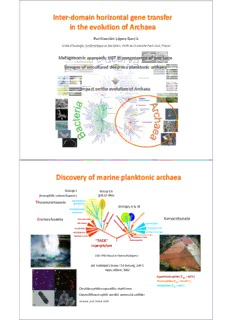
Inter-domain horizontal gene transfer in the evolution of Archaea PDF
Preview Inter-domain horizontal gene transfer in the evolution of Archaea
IInntteerr‐‐ddoommaaiinn hhoorriizzoonnttaall ggeennee ttrraannssffeerr iinn tthhee eevvoolluuttiioonn ooff AArrcchhaaeeaa PurificaciónLópez‐García Unitéd’Ecologie, Systématiqueet Evolution, CNRS & UniversitéParis‐Sud, France Metagenomic approach: HGT in pangenomes of twolarge lineagesof uncultureddeep‐seaplanktonicarchaea Impact on the evolutionof Archaea DDiissccoovveerryy ooff mmaarriinnee ppllaannkkttoonniicc aarrcchhaaeeaa Group I Group1A (mesophilic crenarchaeota) (pSL12‐like) Thaumarchaeota Cenarchaeum symbiosum GroupsII & III Nitrosopumilus maritimus Crenarchaeota Euryarchaeota Thermoproteales Sulfolobales Halobacteriales Pyrodictiales Methanosarcinales Caldisphaerales Methanomicrobiales Desulfurococcales Methanobacteriales Methanococcales "TACK" Methanopyrales superphylum (16S rRNA‐basedarchaeal phylogeny) JedFurhman'steam / Ed DeLong, 1992 manyothers, later hyperthermophiles (T > 80°C) opt thermophiles (T >40‐45°C) opt mesophiles (T <40°C) opt CandidatusNitrosopumilusmaritimus Chemolithoautrophicaerobicammoniaoxidizer Könneke et al, Nature 2005 GGrroouupp II aarrcchhaaeeaa:: Group I TThhaauummaarrcchhaaeeoottaa Groups II/III Euryarchaeota Schleper & Wagner, 2011 pSL12‐like Crenarchaeota ‐ High diversityin sea, soil, freshwater Non cultivatedbut abundantin deepocean Group I 'classic' waters(up to30% picoplankton) ‐Novelphylum Thaumarchaeota Brochieret al., Nat. Rev. Microbiol. 2008 ‐Energymetabolism: aerobic oxidationof ammonia NH +NO ‐ 4 2 ‐C metabolism: autotrophicand/ormixotrophic? 3‐hydroxyproprionate/4‐hydroxybutyrate genes in genomesof C. symbiosum& N. maritimus Schleper, Nature 2008 DDeeeepp‐‐sseeaa ppllaannkkttoonniicc ccoommmmuunniittiieess Heterotrophy + Autotrophy Deep sea + Mixotrophy > 1000 m depth No light Oligotrohicconditions High pressure(1 bar per 10m) Lowtemperatures~2°C TThhee eenniiggmmaattiicc mmaarriinnee Group I GGrroouuppss IIII && IIIIII aarrcchhaaeeaa Groups II/III Euryarchaeota Crenarchaeota 70‐130 m • Exclusivelymarine • Non cultured • Metabolism& lifestyleunknown Frigaard et al., Nature 2007 GroupII • 'Majorityconsensus' • Usuallyhigherabundancein MGII genome surfacewaters(DCM) (de novo assembly, SOLiD) • Surface waters GroupIII • Deep‐sea waters • Proteorhodopsin Iversonet al., Science 2012 MMeettaaggeennoommiiccss:: ggeettttiinngg aacccceessss ttoo tthhee ggeennoommeess ooff uunnccuullttuurreedd mmiiccrroobbeess [Single cell genomics] DNA Massive sequencing Metagenomic libraries (Shotgunlibraries‐Sanger sequencing) fosmids, BACs Direct NGS sequencing: pyrosequencing 454 / Illumina Gene contentof given environment Gene content& genomestructureof phylogenetically identifiableorganisms (Genomescaffoldsin low diversityenvironmentsorof dominantorganisms) AArrcchhaaeeaa iinn ddeeeepp‐‐sseeaa mmeettaaggeennoommiicc lliibbrraarriieess 1,8 Euryarchaeota Group III n=5413 1,6 Euryarchaeota Group II s mid 1,4 n=20757 Thaumarchaeota pSL12-like s o Thaumarchaeota Group I g f 1,2 'classic' n ari 1 e b n=38704 d- 0,8 mi s o 0,6 A f N 0,4 D S r 0,2 6 1 ‰ 0 KM3 AD1000 SAT1000 3000 m 1000 m depth Group I pSL12-like Groups II/III Average depth 2000 m Warm at depth, ca. 13-14ºC Crenarchaeota Euryarchaeota 16S rRNA genesin fosmids Thaumarchaeota Euryarchaeota pSL12‐like OTU Operational taxonomicunit 98% 16S rRNA identity HHGGTT ffrroomm iinn ddeeeepp‐‐sseeaa aarrcchhaaeeaa?? Thaumarchaeota (lowGC 33.8%) Molecularphylogeneticanalyses (ML) Genesin 21 fosmids (200 ORFsThaumarchaeota 90 ORFsGII/III Euryarchaeota) Genesin fosmid ends (12,774 fosmids from3 metagenomic libraries) Euryarchaeota (high GC 58.7%) 590 fosmids dual affinity e.g. bacterial-like putative HGT case Martin‐Cuadradoet al., ISME J (2008) IInntteerrpprreettiinngg pphhyyllooggeenneettiicc ttrreeee ttooppoollooggyy Bacteria Horizontal Eukaryotes genetransfer (HGT) Archaea HHGGTT ffrroomm ddiissttaanntt ddoonnoorrss iinn ddeeeepp‐‐sseeaa aarrcchhaaeeaa?? Genesin 21 fosmids Genesin 590 x 2 fosmid ends s) d mi s o % f s ( d n e d mi s o n f o ati affili c eti n e g o yl h P 10‐20 % Thaumarchaeota ‐Bacteria Between20 and 30% HGT 10‐38% Euryarchaeota ‐Bacteria eventsfromdistant donors Brochier‐Armanet, et al. ISME J 2011 HHoorriizzoonnttaall ggeennee ttrraannssffeerr ffrroomm ddiissttaanntt ddoonnoorrss iinn mmaarriinnee aarrcchhaaeeaa ‐ Real? ‐ Genome‐wide? ‐ Ancient, recent, ongoing? ‐ Which genes are transferred? GGeettttiinngg aacccceess ttoo ggeennoommeess ooff uunnccuullttuurreedd aarrcchhaaeeaa 997 deepMediterraneanarchaeal fosmids sequenced& analyzed 40 genesusuallyin single copy Thaumarchaeota Euryarchaeota GII/III Number of fosmids 545 452 Total sequence (bp) 19,717,229 16,310,525 Mean fosmid length (bp) 36,178 36,085 GC content (%) 47.13 54.82 rRNAs(5S, 16S, 23S) 42 28 tRNAs 610 489 Mean of 40 single-copy genes 16.5 9.3 ORFs ≥ 90 nt 150,170 164,605 Number of annotated genes 23,665 13,227 Orthologous gene clusters (OGs) 2,098 3,527 Orphan genes 416 1,293 ~ 16 Thaumarchaeota genomeequivalents ~ 9 GII/III Euryarchaeota genomeequivalents Thaumarchaeota Euryarchaeota FFuunnccttiioonnaall ppootteennttiiaall ooff ddeeeepp‐‐sseeaa aarrcchhaaeeaa Thaumarchaeota nes Ammoniaoxidizing e g N° Ureametabolizing PotentialautotrophicC fixation Proposed 3‐hydroxypropionate/4‐ hydroxybutyrate cycle for autotrophic carbon fixation by N. maritimus GII/III Euryarchaeota No proteorhodopsin homologs genuine deep‐sea dwellers likely versatile heterotrophs TThhaauummaarrcchhaaeeoottaa aanndd GGIIII//IIIIII EEuurryyaarrcchhaaeeoottaa ppaannggeennoommeess Pangenomes: + unculturedGroup II euryarchaeote + Nitrosopumilusmaritimus + Nitrosoarchaeumlimnia + Cenarchaeumsymbiosum 16S rRNA genes GGeennee ccllaasssseess PPhhyyllooggeenneettiicc aannaallyysseess * Orthologousgeneclusters (OGs) 2,098 genes (OGs) ‐Thaumarchaeota 3,527 genes (OGs) GII/III Euryarchaeota Thaumarchaeota GII/III + local database –genomes: Euryarchaeota Shell 120 archaea, 297 bacteria, 120 eukaryotes Lineage‐specific Automated core Core ML phylogenetic Crenarchaeota Euryarchaeota Bacteria trees Eukaryotes Manual !!! Phylogeneticorigin HHoorriizzoonnttaallllyy ttrraannssffeerrrreedd ggeenneess ((HHTT‐‐ggeenneess)) iinn ''sshheellll'' ccllaassss To Thaumarchaeota To GII/III Euryarchaeota Late HGT events (recent import) HHTT‐‐ggeenneess iinn ''lliinneeaaggee‐‐ssppeecciiffiicc ccoorree'' ccllaassss To Thaumarchaeota To GII/III‐Euryarchaeota Ancient HGT events 196 out of 290 (67%) early HT‐genes also present in soil Thaumarchaeota AArrcchhaaeeaall ppaannggeennoommeess:: ggeennee ccllaasssseess aanndd HHGGTT ddoonnoorrss DONORS DONORS Thaumarchaeota HT‐genes: (2,514 genes) HGT HGT 23.9 % 29.7 % GII/III HGT Euryarchaeota (4,820 genes) HGT CCooddoonn uussaaggee iinn ddiiffffeerreenntt ggeennee ccllaasssseess PCA Thaumarchaeota Thaum‐specificcore_earlyHT‐genes Eury‐specificcore_earlyHT‐genes Thaum‐specificcore Eury‐specificcore Euryarchaeota Archaeal corein Thaum Archaeal corein Eury Thaum‐shell_lateHT‐genes Eury‐shell_lateHT‐genes (GC content bias) No difference of codonusage among gene classes: genes adapted to their genomic environment Deschampset al., GBE, 2014
Description: